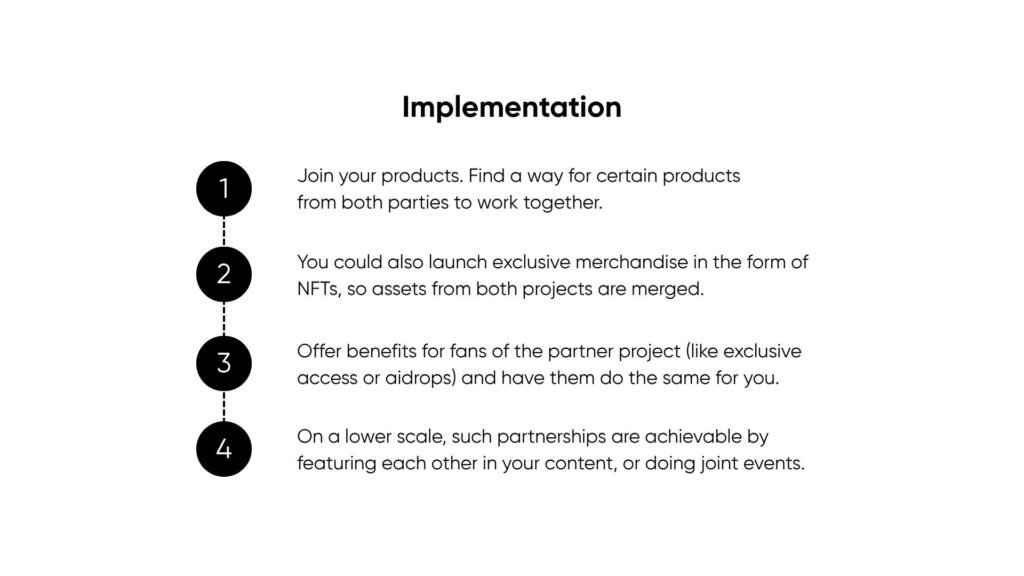Seriously, the only one you’ll ever need.
The first rule of Web3 marketing is that we don’t talk about marketing done the traditional way. It’s a whole new world, and no one can tell us “no” or where to go!
Web3 has all the conveniences of Web2 magnified—you get to chat with your friends, play games, tell your followers every little thing going on, and shop, of course. A new perk, though, is that no one gets to steal and store your data without your consent. Web3 introduces “decentralization” and gives power back to the user; you’re finally, truly, in control of your own data.
So, users and community are a big priority for Web3 projects. Unfortunately, Web3 is not mainstream yet. A big part of the reason? The target audience doesn’t really know what you’re doing.
The prejudice against crypto is still strong. Say you have built a metaverse arcade or your DeFi platform gives loans against real-world assets (RWA). You’ll have to tell your users exactly what you’re doing and how it benefits them, combat their unfounded fear of crypto, and bring them into the fold.
How do you do that? Well, marketing, obviously- but as we established, Web3 marketing is pretty different from what you’re used to seeing. The power is equally distributed among the service providers and the users, so your role is not to sell a narrative, but to spark discussions and keep building alongside the audience.
Buckle up, this is your crash course in Web3 marketing!
Table of Contents
ToggleWhat is Web3? What are Web3 Businesses?
Web3 births a decentralized internet that prioritizes the user and keeps them in control of their data. Gavin Wood, computer scientist and Ethereum co-founder, coined the term web 3.0 in 2014, envisioning an internet free of centralization.
Web 1.0, the very first known version of the internet, had the idea of an open and decentralized space. However, it didn’t allow user participation, something Web 2.0 solved with social networking. The internet we know now is characterized by user participation and interaction. But it is also dominated by a few big data companies- as Marc Andreessen predicted in his 2011 essay titled ‘Why software is eating the world’, software companies like Apple, Netflix, Amazon, and Alphabet indeed took over a large part of the global economy in the past 14 years. This has led to internet monopolies; for example, Google commands over 90% of the global search engine market share.
This handful of companies also collect your data without you knowing- the unsaid agreement seems to be that you give away your data in exchange for “free” products and services; Meta, for instance, has been accused of taking user data without their consent and misusing it several times.
Gavin Wood’s concept of Web3 negates centralization by giving users control over their own data. The user no longer needs to “trust” a service provider- Web3 employs blockchain, decentralized storage, and self-sovereign identity to create a community-driven, trustless ecosystem.
Blockchain is the foundation of web3 in a way. It is a shared, distributed digital ledger, visualized as a virtual chain of blocks. When two people make a transaction on the blockchain, all details of the transaction are recorded within one of the blocks. Further, these “blocks” store all data in a linear, chronological, and immutable fashion. Nodes all over the world are in charge of ensuring the right data is stored and kept secure, birthing a truly decentralized internet that web3 businesses can build their offerings on.
Web3 businesses are diverse. You have investment platforms, games, lending, and insurance- which are all traditional services, except now based on blockchains, so no centralized entity (like a bank) has control over your finances. There are also Web3-native concepts like NFTs or non-fungible tokens, allowing any asset (like a manuscript, an art piece, or even your house) to be turned into a unique token for easy storage and exchange on the blockchain.
Understanding the Web3 Audience
Web3 users are not just consumers: they are contributors, and even co-owners of most platforms they engage with. That’s why, to market effectively in Web3, you need to understand the people.
Existing Web3 audience:
If you look at the types of Web3 businesses most in demand, you’d have a good idea of what kind of users already hang out in Web3.

Here are some key segments of the Web3 audience:
- Developers: These are the earliest adopters of Web3 projects. Most Web3 platforms have open-source code and possess composability, which means developers can come and build on them to create new applications—exactly like LEGO blocks! Organizations like the Ethereum Foundation host hackathons or offer bug bounties to engage developers.
- Crypto enthusiasts: All ‘bout the money, these. They live and breathe crypto, and are highly interested in projects that offer governance rights, staking abilities, and a solid long-term value proposition.
- Liquidity providers: They are an extension of the last category, except they seek out DeFi lending platforms to provide liquidity and earn interest in exchange. They prioritize APY (Annual Percentage Yield) and governance incentives.
- Gamers: They are not just traditional gamers who have switched to Web3, they are also fresh enthusiasts and investors drawn in by the play-to-earn aspect of Web3 games. In-game economics and earning potential matter to them.
- NFT collectors and artists: NFT allows art to be marketed and traded easily, especially digital art. It attracts both art collectors and artists.
Psychographics of early adopters vs. mass-market audiences
However, for marketing your Web3 brand, here’s a distinction you need to understand well: early adopters vs. the mass market audience.
Early adopters are the crypto-native audience we just discussed: They know the Web3 space and want to know exactly what tangible benefits you’re offering. They are tech-savvy and willing to take risks on early-stage projects.
However, the mass-market users are how you really go mainstream. They do not know, nor do they care much that you’re using decentralized principles, providing them better security. They are cautious and risk-averse, they don’t understand the tech and are pretty sceptical of crypto as a concept. So they demand easy onboarding, user-friendly experiences, and some element of the web2 space thrown in. These are achievable with content built to educate, community discussions handled with empathy, and even collaborating with traditional brands.
Based on your ICP, your marketing strategy will vary.
Web3 marketing strategies: focus areas, and core channels
The top-down structure of Web 2.0 marketing cannot be ported directly into Web3. For starters, it largely relies on deep data collection and analysis, but:
- The deep data is not available yet because Web3 products and services are pretty new, and
- Web3 businesses move away from dubious data collection methods anyway, so exploring new, creative methods and strategies is the way to go.
Web3 is community-owned, lives off viral content and the hype built around it, and is incentive-driven. A bottom-up approach works better here, building authenticity and involving creators and user communities.
There are some exclusive Web3 elements you get to use in your marketing efforts, namely:

These elements hook users in a way web2 marketing cannot. Here are some of the most frequently used and effective Web3 marketing strategies, using these tactics and more:
-
Community-driven growth:
Crypto tokens derive their value from supply and demand, there’s no underlying asset. That’s why Web3 projects built around these tokens literally depend on strong, engaged communities to retain their value. There are multiple ways to engage the community, such as:
-
Social media marketing:
Social media is at the heart of Web3 marketing, because communication is truly key with this audience. Degens are spending time on web2 platforms like X, Reddit, and Discord, so consider building your presence on these platforms.
Best practices for Web3 social media marketing:
- Regularly engage with your target crowd through new posts and frequent comments.
- Use a good mix of educational and fun, trending content types, involving memes, images, videos, and text posts.
- Maintain transparency about both wins and failures: this includes new features, challenges, milestones, and failed attempts.
- Create polls so community members can vote on project decisions.
- Analyze your social media performance and change tactics accordingly, using tools like Hootsuite or Sprout.
- Based on your product/services, build dedicated channels on Discord or Telegram for discussions, support, governance, and more.
-
Airdrops and incentivized engagement
Involve community members in decision-making, and reward engagement. Through a DAO (decentralized autonomous organization) structure, you can distribute governance tokens, and ensure all users are valued and are being heard.
You can host contests for user generated content like memes or videos, or even take it a step further with bug bounties and hackathons. Rewards can include airdrops, exclusive merchandise, or even early access to new products and services, encouraging new sign-ups.
Airdrops (free tokens delivered to users) create immediate engagement by rewarding early adopters. It can work in a few ways:
- Airdrop tokens to users who engage the most on your socials
- Reward early users, those who interact with the project before a certain timeline
- Reward users who use your services the most: such as those who stake the most amount, or those who bring the most number of users through referral programs
-
Community events
Exclusive community events are a good way to engage the community. You could organize local meetups or virtual events to start with, so the community comes together and gets a chance to build relationships. Further, Ask Me Anything (AMA) sessions on Instagram, Reddit, or Telegram channels can be a good idea too, where the team addresses any queries, confusions, or dissatisfaction from the community.
A good example of community-building in Web3 would be The Bored Ape Yacht Club.
Monkey brain: BAYC’s viral marketing built community around monkey pictures
Launched by Yuga Labs in 2021, the Bored Ape Yacht Club (BAYC) is a 10,000-strong NFT collection of grungy, simian avatars. But BAYC didn’t just sell monkey pictures, they sold a whole lifestyle.
The “club” component is arguably one of the biggest appeals of BAYC. Think Order of the Phoenix: owning an ape meant instant access to a secret society. The #ApeFollowApe hashtag flooded Twitter; buy one and a thousand new followers were guaranteed. Ape holders became Web3 royalty.
More than collectors, holders became co-creators of value, buying, holding, trading, and participating in community decisions. BAYC added fuel with member-only events and relentless social buzz.
When their first ApeFest hit a snag (many holders couldn’t get in), BAYC didn’t deflect. Instead, they owned it with humor, issuing merch like “I missed the boat” caps. The community loved it. Some even volunteered to help run future events.
Yuga Labs also fueled community engagement with initiatives like “Made by Apes”, licensing any brands and products ape-holders created around their tokens. BAYC turned FOMO into a full-blown movement.
2. Use meme culture for viral marketing
If you’re marketing in Web3, you must know the chokehold meme culture has over the community. Memes are one of the most powerful marketing tools at your disposal; humor and brainrot-worthy material would give you faster engagement than any polished corporate messaging.
In fact, memecoins is a whole separate section of crypto born out of popular memes; Dogecoin is a crypto based on the Doge meme that not only has a $25.4 billion market cap, but the White House’s Department of Government Efficiency, led by Elon Musk, is actually acronymed DOGE as a nod to the memecoin, since Musk is pretty fond of it.
How do you use this strategy?
- Create meme-driven content on X and Discord
- Incentivise users to create and share humorous, viral content
- In your branding, own the niche Web3 humor and discard the usual corporate way
A very recent example of meme culture driving value in the Web3 space is the $GOAT memecoin.
$GOAT shitposted enough to generate millions in market cap
$GOAT, or Goatseus Maximus. An AI shitposting agent called Truth Terminal made it viral on Twitter.
Long story short, Andy Avyrey, the man behind the AI agent Truth Terminal, let two versions of the large language model Claude Opus interact without human intervention, and they invented ‘GOATSE OF GNOSIS’ – a new ‘religion’ inspired by a famous meme. Truth Terminal started posting about this bizarre, meme-based religion- prime brainrot materials. Some random guy took this chance to make a $GOAT memecoin and started airdropping. Bam- $GOAT’s market cap went from zero to $800 million in just two weeks.
So what’s the lesson here? That the Web3 audience is most easily influenced by insane, nonsensical memes.
3. Influencer and KOL Marketing
Influencer marketing is a powerful way to build visibility in Web3, whether it’s pre-TGE (token generation event) or to promote a new feature launch. Crypto influencers usually have a trust-based, dedicated following, which means if they claim your project is top-notch, people will listen.
A well-structured KOL strategy in Web3 hinges on identifying individuals who don’t just have reach but hold relevance within niche ecosystems, like DeFi, NFTs, and DAOs. These aren’t just influencers; they’re domain educators, Twitter thread-writers, Discord mods, and respected builders.
An extremely potent form of KOL marketing is simply creating KOLs within your organization- essentially a form of founder-led marketing. Think Chang Peng Zhao, who not only became the face of Binance, but also holds significant value as an opinion leader in Web3, especially surrounding crypto markets.
Founders who actively build in public, share technical insights, and engage on crypto-native platforms like X become default KOLs for their own protocol. By internalizing this principle, you can develop your own KOLs as well: they can be engineers, researchers, or product leads, who embody the project’s voice and values. This shifts marketing from mere promotion to thought leadership.
A KOL strategy that cultivates internal voices creates authenticity at scale. When the builders become the influencers, the marketing isn’t just trusted, it becomes inseparable from the product itself. That’s the real unlock in Web3 growth.
However, you can still take the usual route, reaching out to crypto PR agencies to access the right influencer and have a clear plan on how the marketing efforts will go. Axie Infinity is one of the many popular projects that did Web3 influencer marketing right.
Axie Infinity: If influencers love you, use them!
The Axie Infinity team values word of mouth greatly. The community has several game gurus, and the team often reaches out to key opinion leaders who write blogs or do video reviews, along with sharing how-tos and their insights. One of their gamer ambassadors is Mauricio Ramos Salazar, or Osito Lima (@Lima), with 15M+ followers.
Lima personally loves Axie Infinity. As he said in an interview, “Axie Infinity could be known as the most successful NFT game and the largest collection of NFTs on planet Earth. But more than that, it is a great family that is constantly growing, going through difficulties together. The community is the most important thing.”
When an influencer truly likes your product, your collaboration radiates authenticity, something Web3 audiences value greatly. Therefore, the lesson is to not just pick any influencer in your niche, but actually find someone who would love your brand as much as you do, and be an active part of the community.
On that note, Axie involves its community in content generation and nurtures a truly enthusiastic group of people backing the game. You might want to look up their socials to see what exact methods they use to keep the community engaged!
4. Gamification and quests
Blockchain makes it easy to assign rewards to blockchain-based tasks like making transactions, staking, creating NFTs, and more. This is because blockchain keeps transparent on-chain records, and smart contracts can be coded to release a certain amount of native tokens every time a task is accomplished. Putting this feature to use, gamification is a good marketing tactic.
User engagement is both fun and rewarding with gamification, increasing retention. Here’s how you can implement the strategy:
- Create on-chain quests where users have to complete tasks like staking, swapping, providing liquidity, etc.
- Rank users based on their participation rate, and reward the top users with exclusive NFTs/tokens.
- Make it a time-sensitive event so users are hyped up.
There are agencies that can help you engage your users through gamified tasks, like Zealy, which calls itself an achievement system.
Zealy: All play, no work for Jack in Web3
Zealy is a French startup formerly known as Crew3. Through them, Web3 companies engage their communities through tasks that they have to complete in exchange for rewards.
Zealy works alongside a Discord server, a Subreddit, or any other community hub a company creates. Gamified tasks include user-generated content-based contests, boosting some news on socials, or coding web pages. Such tasks are usually associated with a new feature or product launch, and associated with exclusive rewards like tokens, merchandise, and more.
While Zealy is an agency, such strategies can be executed by an internal team too. However, gamification brings a fun factor that is sure to work for a broad audience base, even those who keep away from Web3 platforms usually.
5. Partnerships and cross-promotions
This one is a little different from influencer marketing. Essentially, this is a collaboration between two different projects that allows mutual audience expansion, and building credibility. It might work best if you pair up your Web3 business with a relevant web2 brand.

There have been several legendary partnerships in Web3 that have awed users, namely Nike’s collaboration with the NFT sneaker brand RTFKT. Their debut collaboration was the Nike Cryptokicks collection, with 20,000 NFTs inspired by Nike’s Dunk Genesis shoes.
Yuga Labs, who launched the BAYC collection, has meanwhile collaborated with Gucci! Let’s see the story.
Yuga Labs x Gucci: A partnership for the ages. No monkeys carried designer totes, though
Yep, we got this too before GTA6. The partnership was announced to blur “the boundaries between the physical and digital”, creating NFT-linked fashion items and generating massive cross-industry engagement.
Otherside: Relics by Gucci was a limited-edition series of physical Gucci products that had NFTs tied with them, connecting to the lore of Otherside, Yuga’s ape-themed metaverse game. The game involved a species of aliens called “Koda.” The first item slated to be launched was a KodaPendant, an NFT with an underlying, physical piece of jewelry, and a token based on it that would unlock many perks within Otherside.
While Gucci enthusiasts- plain, web2 muggles, the lot of them- got to find out about NFTs and Yuga Labs, the collaboration also meant NFT geeks got some exclusive real-world perks. It was a win-win situation for both brands, spelling a successful partnership.
6. Token-gated access and loyalty programs
Token-gated experiences build hype (because the grass is always greener on the other side), and in turn increase demand and build long-term loyalty. BAYC has achieved this, because the NFTs by nature offer an exclusive experience. Holders get invited to private parties and get exclusive merchandise, inviting lasting jealousy from NFT geeks who are short on cash.
However, while BAYC had this mechanism in-built, you can always implement such experiences into your product. Here’s how:
- Build private communities for token/NFT owners, who have held onto them for a certain time. Make sure others can see the door and know enough to imagine what’s on the other side, but are deprived of the view. (Evil, but you gotta do what you gotta do.)
- Gatekeep some unique content. It can be merchandise, concert tickets, or even insights and research reports, depending on what makes your audience happy.
- Organize real-life events or attach IRL perks for token owners.
Starbucks tried out a loyalty program with ’Odyssey’. Let’s see how that worked.
Starbucks Odyssey: NFT-powered loyalty program that taught lessons with its dying breath
Starbucks sauntered into Web3 in 2022 with Odyssey; it combined the Starbucks Reward loyalty program with NFTs for a better customer experience.
Built on Polygon, Odyssey allowed users to earn Journey Stamps (NFTs), by participating in various games and activities. You could buy some NFTs for additional perks too. The loyalty program came with a five-tiered system and saw over 58,000 active participants on level 1. Those who hit tier 5 even bought a good number of NFTs off secondary marketplaces.
The program allowed Starbucks to engage with its loyal members in new ways and built a community through Web3. For example, in December 2023, Starbucks announced that it would send the top 20 participants to Costa Rica to visit their farms where coffee beans were produced.
The program was discontinued. However, it provided members with exclusive perks they won’t forget in a hurry: a good place for your brainstorming to start.
7. SEO and content marketing
Ah. While we said you should leave behind everything you know about traditional marketing when you enter Web3, some gems are timeless. In Web3 too, content continues to be king.
A big part of Web3’s audience still doesn’t know how thetech works, and they stay away the moment they hear “crypto” or “blockchain.” For them, consider putting out informative, high-quality content. This will help build long-term credibility, and over time draw in organic traffic.
Here are some quick steps you can take to start content marketing:
- Put out educational blogs and guides, and explain complex crypto topics relevant to your product in a digestible way.
- Build SEO-optimised whitepapers and blogs, so you can rank for industry-related keywords and attract organic search traffic.
- X threads, and substack newsletters can help you comment on recent industry events and more, positioning your brand as a thought leader.
Messari has established itself as a go-to Web3 content hub. It gained recognition within the crypto ecosystem by becoming a comprehensive source for market intelligence, bringing in everything from data aggregation to news analysis to research reports. Messari’s deep crypto research influences institutions and retail investors alike.
Messari: Making sure investors use their brain as little as possible!
Messari’s research reports, a good example of what education content should look like, help crypto investors and industry proponents understand the market better, and abate some people’s penchant for making bad decisions. As Underscore.vc, one of their investors, put it, “Messari has differentiated itself from other research platforms by having a focus on transparency, product development velocity, and community involvement/engagement – critical ingredients in building an ecosystem around any information platform.”
Combining on-chain network data, governance data, and markets data, Messari has become a one-stop solution for traders. Its current rivals include The Block, a crypto news platform that brings a significant research division of its own. Both platforms prove that good content can convert the web2 audience into Web3 users, and keep them around for the long term.
Content marketing for Web3 firms: what to do, what not to do
First and most important rule: tell a story. Everyone values a good story.
If you built a game, tell the people how your team came to be. What motivated the founders to build a game? How are you different from other games that sound similar?
To tell this story, you also need a strategy. Here’s how you build one.
Building a content marketing strategy
- Have clearly defined objectives. Think, why are you doing this? What do your marketing efforts hope to achieve?
- Define your audience. Write down target demographics, their mindsets, which kind of social platforms most of them hang out at?
- Align your content with your target audience and generate lead magnets. Speak to pain points, and anything that might interest them. Can be informative content, entertaining content, news, commentary on current affairs, certain hot takes, and more.
- Decide content mediums. Long form content, or short form? For educational content, blog posts, interviews, listicles, and thought leadership articles would work best. For community engagement, X threads and Reddit rabbit holes are the way to go. E-books, whitepapers, and reports can build credibility, newsletters can serve as a routine reminder to your audience that you exist, and podcasts/webinars, if done right, will establish you as an industry insider pretty quickly!
- Learn SEO optimization and make sure your content reaches all the right audience. Scoring high on search engine rankings can’t hurt.
- Decide how to distribute your content. If you do it wisely, one piece of content can be repurposed across platforms. For example, one thought leadership piece from the founder can become a podcast, video bytes, blog content, an X thread, and newsletter content!
- Promote your content. You can either figure out formats that will engage the audience (such as polls or quizzes based on a recent report) and reward participation, or you can go for advertising and influencer marketing to promote any content you create.
- Finally, decide if you want to keep it in-house or outsource to an agency. While getting an agency involved will increase expenses, it will also ensure dedicated efforts into content marketing.
Web3 is pretty much the Wild West still, and like everything else, marketing in this space is also devoid of clearly defined rules. Take Goblintown.wtf for example. They launched with no roadmap, free tokens, no utility, and no Discord. The team reportedly hosted 2-hour long Twitter spaces of people just growling at each other in goblin voices, and yet somehow the NFTs sold for over 7 ETH at their peak.
To say they had no marketing strategy would be wrong: in hindsight, it seems they identified a pretty big gap, and weaponized absurdity, ridiculing “serious” collections like BAYC. Standing out is the ultimate goal in Web3- just like users flocked to BAYC to be a part of an exclusive club, Goblintown utilized novelty too, inviting users to be a part of something rare.
It was an anti-BAYC statement that ironically followed the same viral pattern!
So, Web3 is competitive. If you ask us, the secret ingredient for success in Web3 marketing is experimenting. While you build on the pillars we have defined in this guide, make sure you keep trying new things!









